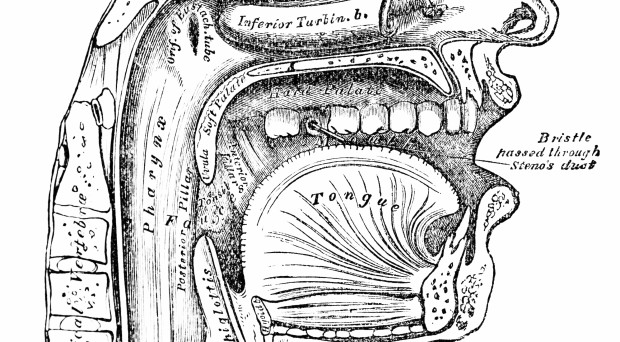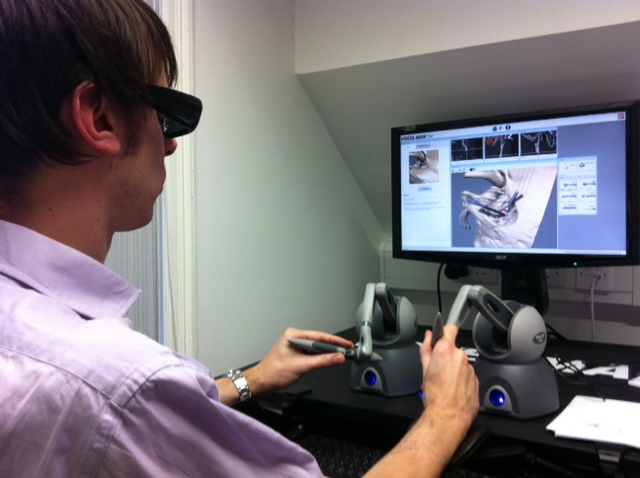
The BACO academic committee planned a CSC to provide a good environment for hands on training after the successful pilot of the 1st CSC in Glasgow, 2012. This was targeted not just at trainees but also consultants and other professionals with the aim of using the latest in simulation technology to help in practicing new techniques while continuing to maintain skills in some sub-specialist areas that only may be required in emergency situations.
Simulation in Otorhinolaryngology
Within surgery, the main goal of any training method is the positive transfer of skills to the operating room and there are a wide variety of simulators available to practice different ear, nose and throat (ENT) surgical techniques.
Within surgery, the main goal of any training method is the positive transfer of skills to the operating room and there are a wide variety of simulators available to practice different ear, nose and throat (ENT) surgical techniques. Most outpatient departments will have access to plastic models and spare instruments and there are many articles in the literature which advocate the use of home-made simulators, such as tonsil tie trainers, quinsy aspiration trainers and myringotomy trainers.
Cadaveric dissection is still a key method of training within Otorhinolaryngology and is a form of high-fidelity simulation. For example, as part of the Advanced Trauma Life Support (ATLS) Course, trainees will have access to animal specimens for practicing tracheostomy, and this method of hands-on learning has been found to be very beneficial. However this method is now mainly reserved for practical dissection courses held throughout the United Kingdom and internationally, rather than being readily accessible by all trainees.
The human temporal bone is a 3-dimensionally complex anatomic region with many unique qualities that make anatomic teaching and learning difficult. Simulation methods using bone laboratories and cadaveric temporal bones have been in use for over 50 years. However due to increasing maintenance costs and ethical issues such as risk of communicable diseases and the concerns surrounding the Human Tissue Act, the use of cadavers and animals has been waning in recent years.
Otolaryngology trainees now perform fewer cadaveric temporal bone dissections than previous generations, and what few opportunities they do have are usually in the form of expensive training courses rather than in on-site hospital bone laboratories. To overcome this lack of exposure, novel simulation techniques have been developed. These include man-made Pettigrew plastic temporal bones and the more recent development of virtual reality simulator training systems.

Virtual reality systems present a computer generated visual and auditory experience that allows a user to be immersed within a computer generated “world” for various purposes. These virtual reality simulators use computer modelling and complex software to emulate patient interaction.
There are several different virtual reality temporal bone simulators that have been described in the literature. The Voxel-Man Tempo simulator is the only one currently commercially available in the United Kingdom (Figure 1). The system uses 3D models of the skull base to provide realistic cases for trainees to practice temporal bone drilling skills and provides visual and haptic feedback, allowing trainees to identify anatomical structures and practice their drilling technique.
This type of virtual reality training system thus provides trainees ample opportunities to practice such difficult surgical procedures.
The speciality of otolaryngology has also developed virtual reality simulation systems for functional endoscopic sinus surgery (FESS). Previously training for this type of surgery was only performed on cadaveric specimens at courses. However, to get proficient at this type of surgery, repetition is key. In a similar fashion to temporal bone surgery, this simulator uses visual and haptic feedback to simulate a FESS procedure with the option of various instruments. This type of virtual reality training system thus provides trainees ample opportunities to practice such difficult surgical procedures.
Examples of Sections at the CSC
Paediatric ENT
The aim of this station was to teach and refresh consultants’ and trainees’ emergency airway and resuscitation skills in a fully supported environment. The station included part-task trainers for teaching the use of ventilating bronchoscopes and tracheal foreign body retrieval. Simulators were used to allow the participants to lead the management of resuscitation scenarios. An up-to-date knowledge of ATLS was not required as the participants were provided with the necessary knowledge as they progress through the station.
Otology
The otology workshop allowed delegates to practice otological techniques including cartilage tympanoplasty, ossiculoplasty with autologous and alloplastic materials, stapedectomy using laser techniques, and mastoidectomy on both plastic temporal bones and simulated bones. There was also an opportunity to carry out auditory implantations, including various types of cochlear implants. Hands on training on Virtual Reality simulators including Voxelman and VES systems was available.
Facial Plastics
The aim of the facial plastic skills centre was to provide training to ENT trainees in basic steps of rhinoplasty using plastic models. Pig trotters were used to provide training in various skin flaps such as advancement, rotation, bilobe, rhomboid flaps and Z plasty.
Laryngology (Injection & Laser)
This session mimicked an ENT theatre environment where candidates could perform micro laryngeal surgery and use a CO2 laser. Candidates were able to perform every step of the procedure including insertion of the laryngoscope, set up the microscope and use laryngeal micro instruments. This was an unique opportunity to perform simulated laser surgery before moving on to live patients.
Endoscopic Ear Surgery
This was a session to introduce basic concepts and instrumentation in Endoscopic Ear Surgery (EES). There were videos of endoscopic cadaveric dissection from external to internal acoustic meatus but the main focus was the middle ear anatomy and principles of EES. This was followed by endoscopic ear dissection practice on plastic temporal bones to allow delegates hands-on experience.
In conclusion
BACO 2015 was a resounding success with over 1200 delegates and the Clinical Skills Center was deemed by many to be the ‘jewel in the crown’ with more than 400 conference delegates having practical hands on training. This was useful to help trainees and consultants develop and maintain skills for emergency management of ENT conditions while learning new techniques at the forefront of ENT and in a multi-disciplinary setting.
The clinical skills centre also promoted inter-professional development, and working in the new milieu where simulation offers an important route to enhanced patient safety as shown in the CMO’s report calling for this to be integrated in the health service.
Comments